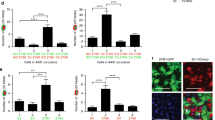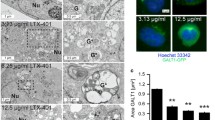Abstract
The activityin vitro of four types of colicins (A, E1, E3, U) against one human standard fibroblast line and against 11 human tumor-cell lines carrying defined mutations of thep53 gene was quantified by MTT (tetrazolium bromide) assay. Flow cytometry showed that the pore-forming colicins A, E1 and U affected the cell cycle of 5 of these cell lines. Colicins E3 and U did not show any distinct inhibitory effects on the cell lines, while colicins E1 and especially A inhibited the growth of all of them (with one exception concerning colicin E1). Colicin E1 inhibited the growth of the tumor lines by 17–40% and standard fibroblasts MRC5 by 11%. Colicin A exhibited a differentiated 16–56% inhibition, the growth of standard fibroblasts being inhibited by 36%. In three of the lines, colicins A and E1 increased the number of cells in the G1 phase (by 12–58%) and in apoptosis (by 7–58%). These results correlated with the data from sensitivity assays. Hence, the inhibitory effect of colicins on eukaryotic cells is cell-selective, colicin-specific and can be considered to be cytotoxic.
Similar content being viewed by others
References
Farkas-Himsley H., Cheung R.: Bacterial proteinaceous products (bacteriocins) as cytotoxic agent of neoplasia.Cancer Res.36, 3561–3567 (1976).
Farkas-Himsley H., Musclow C.E.: Bacteriocin receptors on malignant mammalian cells: are they transferrin receptors?Cell Mol. Biol.32, 607–617 (1986).
Farkas-Himsley H., Musclow C.E., Weitzman S.S., Herridge M.: Acute lymphoblastic leukemia of childhood monitored by bacteriocin and flow cytometry.Eur.J.Cancer Clin.Oncol.23, 411–418 (1987).
Lauková A., Mareková M.: Production of bacteriocins by different enterococcal isolates.Folia Microbiol.46, 49–52 (2001).
Levine A.J.:p53, the cellular gatekeeper for growth and division.Cell88, 323–331 (1997).
Lokaj J., Šmarda J., Mach J.: Colicin E3 enhances the oxidoreductive activity of guinea-pig leukocytes.Experientia38, 1352–1353 (1982).
Mercer W.E.: Checking on the cell cycle.J.Cell Biochem.31 (Suppl.), 50–54 (1998).
Morovský M., Pristaš P., Javorský P.: Bacteriocins of ruminal bacteria.Folia Microbiol.46, 61–62 (2001).
Pestell K.E., Medlow C.J., Titley J.C., Kelland L.R., Walton M.I.: Characterization of thep53 status, BCL-2 expression and radiation and platinum drug sensitivity of a panel of human ovarian cancer cell lines.Internat.J.Cancer77, 913–918 (1998).
Saito H., Watanabe T.: Effect of bacteriocin produced byMycobacterium smegmatis on growth of cultured tumor and normal cells.Cancer Res.39, 5114–5117 (1979).
Schafer K.A.: The cell cycle: a review.Vet.Pathol.35, 461–478 (1998).
Šmarda J.: The action of colicins on eukaryotic cells.J.Toxicol.Toxin Rev.2, 1–76 (1983).
Šmarda J., Macholán L.: Binding domains of colicins E1, E2 and E3 in the receptor protein BtuB ofEscherichia coli.Folia Microbiol.45, 379–386 (2000).
Šmarda J., Oravec C.: Cytocidal effect of bacteriocins toward lymphatic cells. (In Czech)Aktual.Klin.Onkol.21, 209–212 (1989).
Šmarda J., Schuhmann E.: Studies of colicin action on wall-less stable L-forms ofEscherichia coli — I. Degree of attachment and of killing effect on rods and stable L-form cells.Z.Allg.Mikrobiol.19, 511–516 (1979).
Šmarda J., Šmajs D.: Colicins — exocellular lethal proteins ofEscherichia coli.Folia Microbiol.43, 563–582 (1998).
Šmarda J., Obdržálek V., Táborský I., Mach J.: The cytotoxic and cytocidal effect of colicin E3 on mammalian tissue cells.Folia Microbiol.23, 272–277 (1978).
Šmarda J., Fialová M., Šmarda J. Jr.: Cytotoxic effects of colicins E1 and E3 onv-myb-transformed chicken monoblasts.Folia Biol.47, 11–13 (2001).
Šmarda J., Matějková P., Vavříčková A.: Translocation of colicin from the receptor to the inner cell membrane: function of the peptidoglycan layer.Folia Microbiol.47, 213–217 (2002).
Author information
Authors and Affiliations
Corresponding author
Additional information
This work was supported by grant no. 310/98/0083 of theGrant Agency of the Czech Republic.
Rights and permissions
About this article
Cite this article
Chumchalová, J., Šmarda, J. Human tumor cells are selectively inhibited by colicins. Folia Microbiol 48, 111–115 (2003). https://doi.org/10.1007/BF02931286
Received:
Revised:
Issue Date:
DOI: https://doi.org/10.1007/BF02931286




